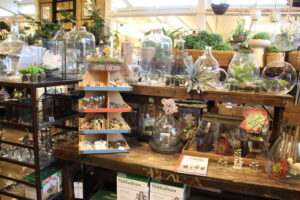We All Scream For . . .
Customers in 40 U.S. markets are going wild for Groupon, a collective-buying website that offers deals at local businesses. With more than 3 million subscribers, it’s a largely untapped market for garden centers to take advantage of. Are you on board?
“While April may not be the cruelest month, as the poet insists, it is most definitely a mean drunk. Make the most of spring’s mood swings and unrelenting rains with today’s deal.”
That’s the beginning of an e-mail message that went out to thousands of Internet users in the St. Louis area on Friday, March 19. It was the introduction to a special deal at Rolling Ridge Nursery in suburban Webster Groves, sent by a website called Groupon.
Be honest: What was your first thought when you read that?
Did you laugh?
Did it furrow your brow, make you curious?
Did it make you want to read more?
Well, a lot of people probably did laugh. It made them curious, and they did read more: of those who received the e-mail, more than 6,000 of them bought the deal for $15, which got them $40 worth of merchandise at Rolling Ridge.
Groupon Basics
Struggling to get traction with younger consumers? Looking for a way to get more visitors to your website, subscribe to your e-newsletter or read your blog? In need of a little marketing boost?
Groupon is a win-win situation for any business, and it’s a home run for a garden center looking to boost awareness in the community. Today, you’re competing not just with the big boxes but also with Starbucks, soccer practice, concerts, restaurant dinners and that fantastic pair of shoes at the local department store so put yourself right in front of your potential customers and strut your stuff!
Groupon has grown to more than 3 million subscribers since its inception in November 2008; it started in Chicago and has since expanded to more than 40 markets across the country, with more than 100 planned before the end of 2010, according to Julie Ann Mossler, Groupon’s PR manager. The company’s 230 employees are all dedicated to promoting local businesses in daily deals to potential customers by e-mail.
When you become a featured business on Groupon, your “deal” goes out to thousands of e-mail subscribers in the area nearest you which means exposing thousands of potential new customers to all the best attributes of your garden center and the products and services you offer.
It’s not a quick fix or a way to make a lot of money, Mossler says, but it is a way to reach potential customers in one fell swoop.
How it Works
The best candidates for being featured on Groupon are already getting good traction in their communities, generating good buzz, positive reviews on the web or through word of mouth. There are two ways to become officially featured, Mossler says.
The first is proactive: A business can reach out to Groupon after visiting grouponworks.com to learn about the process. When a business gets in touch, they’re guaranteed to have an area representative return the call to discuss a potential deal.
The second is a real honor: Sales reps go after the best of the best. The company chases after those, Mossler says, because Groupon wants to feature the most popular local haunts with great reputations.
Either way, it costs nothing for a business to be featured on the site. Groupon makes money by taking a cut of the money from each deal sold. And if a certain number of Groupons isn’t sold for every deal, it doesn’t go through meaning it’s pretty tough for a business to go wrong in trying this out.
Each deal is tailored specifically to the business; a representative works to be sure the Groupon is fair and manageable for the business once it’s been sold to customers. Every deal has a “Fine Print” section that lists all the limitations on customers, including off-limits merchandise and how many can be purchased at one time.
Some have compared being featured on Groupon to being included in a Valpak or similar direct-mail coupon books, Mossler says. But there’s one key difference: With those coupon books, businesses have to pay up front to be included, and there’s no guarantee consumers will respond to the mailings. With Groupon, consumers are the ones who pay up front
Creating a Deal
Harper’s Nursery, based in Phoenix, Ariz., is riding the wave of tech-savvy marketing. After downsizing their budget for Yellow Pages advertising for quite a while, they finally eliminated it altogether, and they’ve replaced those efforts with social media and online vehicles. Harper’s is already doing a lot of things right: getting the word out about the business on Facebook and Twitter; advertising on Google AdWords;featuring coupons on Yelp and Google Maps; even hosting a radio show on Saturdays to establish the store as an expert. Jay Harper, who co-owns Harper’s with his two brothers, keeps track of it all with a list of usernames, passwords and URLs on his desk.
It’s a big change from the advertising of the past, but he sees it as a necessity in the changing retail environment. “It’s hard to keep up on it, but you have to do the best you can,” he says. “[Big boxes] get all the easy sales; we have to earn ours.”
Harper heard about Groupon through a woman who subleases space for a coffee cart in one of his two locations. She had participated and recommended it to Harper. “We thought, ‘What the heck. Right now, we’re willing to try anything.'”
He got in touch with Groupon and worked with a representative to put together a deal during the holidays, obviously the stores’ off-season. (He wasn’t interested in offering a deal during the peak spring season.)
The Harper’s Nursery deal: Customers paid $20 for $40 worth of merchandise, good for anything in stock. The Groupon’s “tipping point” the number of customers who had to buy it for the deal to go forward was 50 users, and this deal sold just under 300.
The Aftermath
After the deal is done, Groupon follows up to debrief and ask about the experience. And the success rate is pretty high: According to www.grouponworks.com, 96 percent of businesses are satisfied with the experience. Ninety-seven percent are interested in promoting their business again through Groupon, and 96 percent will recommend the service to other businesses.
Harper’s is among those high percentages in satisfaction. They had about an 80 percent redemption rate, and among the 20 percent who didn’t redeem their Groupons before they expired on Feb. 1, a few came in after the fact hoping to use the deal anyway. Harper’s offered a small grace period, as many businesses do with ordinary coupon deals, but Jay Harper says he drew the line when someone came to the store in early March looking tobe honored.
Most customers didn’t spend much over the $40 value of the Groupon Harper says the stores’ average sale is $40 but there werea few gems.
“We had some people spend hundreds and hundreds of dollars over their Groupon amount. We developed a handful of really good customers out of this,” Harper says. One woman even bought 11 Groupons, either as gifts or for herself.
There are a few things Harper might do differently the next time around the Groupon’s value could be lower, or the window to use it might be broader but the end result was essentially what he wanted for the store. “By and large, the crowd that uses Groupon is a little younger than our traditional customer, and we exposed a lot of new people to our business. That’s what we were after: to reach some new folks.”
read on to the next page >>


















 Videos
Videos





